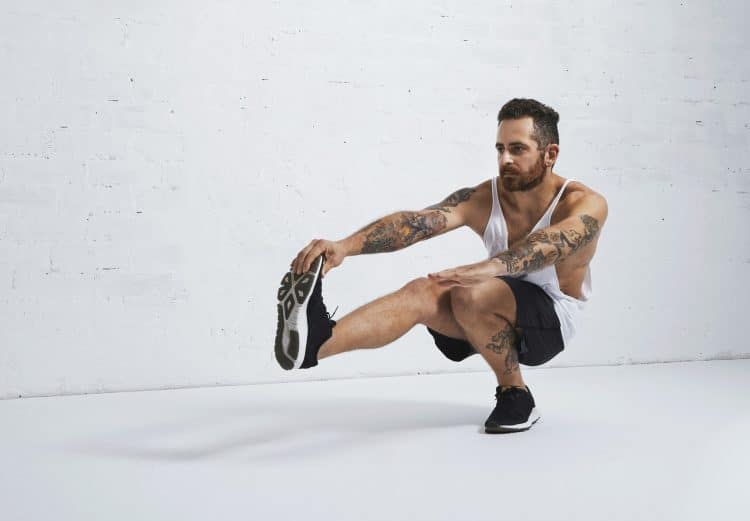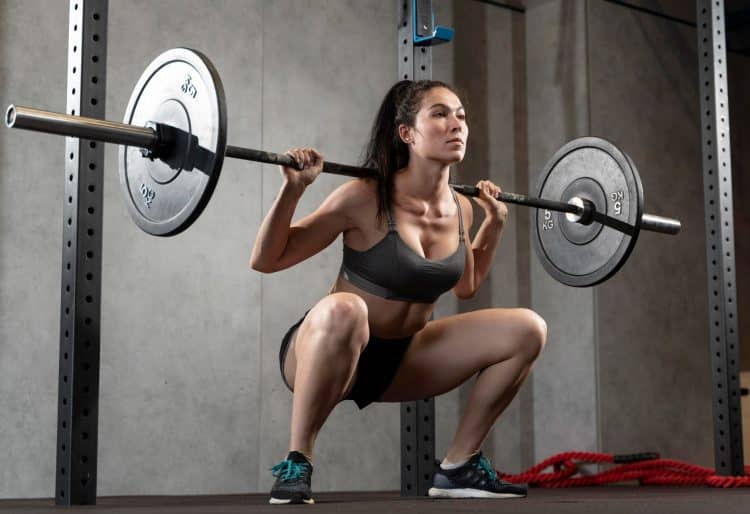Most exercisers love to hate leg training. They love the results, as great-looking legs are highly sought after, but they hate how hard leg training can be. After all, only leg workouts leave you lying on the floor in a pool of sweat, questioning whether you’ll be able to walk out of the gym without help. And post-leg-day muscle soreness can be crippling.
As leg training is so hard, it makes sense to get the most from every lower body workout. Why waste your time and energy on exercises that don’t produce great results? Ineffectual leg workouts are like throwing money down the drain – a waste of valuable resources.
So, with that in mind, in this article, we reveal the best leg exercises for every fitness and strength training goal. Build your workouts around these movements to make your leg workouts as productive as possible.
But before we reveal the best leg exercises, let’s delve into the benefits of leg training so you know exactly what you are suffering for!
About the Experts
This article was authored by Patrick Dale, the Training Editor for Fitness Volt. With hands-on experience in personal training and a background as an ex-Marine, he’s also the notable author of books such as “No Gym? No Problem!”. The content was meticulously fact-checked and authenticated by Tom Miller, CSCS, a content strategist for Fitness Volt, who holds the prestigious Certified Strength and Conditioning Specialist certification.
Benefits of Leg Exercises
It’s undeniable – leg training is hard! It requires determination, motivation, and the willingness to suffer for your gains. It’s no wonder that some lifters are only too happy to skip leg day.
With that in mind, here, in alphabetical order, are the main benefits of leg exercises. Try to remember these the next time you are thinking of training your chest when you should be cranking out some squats!
1. Accelerated Calorie Burn
Your legs make up roughly 40-45% of your muscle mass. As such, leg training burns a lot of calories. (1) Not only that, but sustaining your leg muscles also uses a lot of energy, contributing significantly to your Total Daily Energy Expenditure, or TDEE. Long story short, training your legs will make it easier to get and stay lean.
2. Enhanced Athletic Performance
Whether you want to run faster, jump higher, or kick harder, leg training will help. Leg exercises target the same muscles you use in athletic and sporting activities, and strength built in the gym transfers well to the playing field, fight cage, and running track. There is a reason that athletes put so much effort into leg training; it’s critical for their performance. (2)
3. Improved Balance and Stability
Leg training doesn’t just develop the big muscles in your legs; it also works the smaller muscles that help stabilize your joints. That’s especially true for single-leg exercises. In addition to their muscular effect, leg exercises are also helpful for improving your balance.
Balance and stability make your movements more efficient and also reduce your risk of suffering a fall. While that might not sound important to younger exercisers, it becomes critical as you age. Falls are a leading cause of disability in older people and can even be fatal.
4. Increased Core Strength
Despite working your legs, a lot of lower-body exercises are considered to be full-body movements. We’re talking specifically about squat and deadlift variations. These exercises invariably involve holding a weight in your hands or on your shoulders as you use your legs.
These movements force you to support the load using your core, which is the collective name for the muscles of your midsection. Free core workout whenever you train your legs? Sign us up!
5. Joint Health and Flexibility
Contrary to popular opinion, squats are not bad for your knees, lunges aren’t bad for your hips, and deadlifts aren’t bad for your back. Instead, these exercises take your joints through a large range of motion, which does them nothing but good. Some of these leg exercises are virtually dynamic stretching exercises.
Building your workouts around the exercises in this article will help keep your joints strong and healthy while contributing to your muscle flexibility. All of these benefits will enhance athleticism and long-term functionality.
6. Lower Body Sculpting
It goes without saying that if you want legs that you can be proud of, you need to train them like you mean it. The good news is that by selecting appropriate exercises, you’ll have no problem precisely targeting the muscles you want to develop. So, whether you want to beef up your quads, sculpt more muscular hamstrings, or turn your calves into fully-grown cows, there are exercises you can use to get it done.
7. Mental Toughness and Discipline
Let’s be honest – lower body training is hard. Leg extensions can leave your thighs burning and quivering, while squats take the very air from your lungs and challenge your heart as much as any cardio session.
However, doing hard things is very beneficial and will help build your self-confidence, mental toughness, and discipline. All of these factors transfer to life outside the gym.
Faced with any adversity, all you need to remember is that leg training is harder. As the saying goes, what doesn’t kill you makes you stronger. And that applies to your body AND mind.
8. Optimized Hormonal Response
Leg exercises can trigger a cascade of hormones as your body adapts to the demands of your workout. Heavy squats, deadlifts, leg presses, etc., increase testosterone, growth hormone, and insulin-like growth factor production and also increase insulin sensitivity to optimal uptake of glucose into your muscle cells.
All of these factors can contribute to better metabolic health as well as muscle and strength building. You’ll also feel a sense of achievement and happiness from the endorphins released.
9. Reduced Risk of Injury
Lower leg injuries are common and include knee, hip, and ankle issues. Strong muscles and bones are more resilient and less prone to wear and tear and injuries. Regular leg training can help ward off chronic aches and pains and reduce the chances of acute injuries, e.g., during sports or due to accidents, such as falls.
10. Boosting Cardio & Mobility with Leg Training
Leg exercises, encompassing routines like squats, lunges, and deadlifts, engage multiple large muscle groups, requiring your heart and lungs to work harder to keep these muscles oxygenated. As a result, leg workouts act as a form of disguised cardio, enhancing not only muscular strength but also cardiovascular health, similar to activities like running or swimming.
But the benefits don’t end at the gym door. Every time you bend to pick an item or stand from a chair, you’re performing movements akin to those you practice during leg training. Such exercises improve our day-to-day mobility, making daily tasks smoother and more efficient. This is particularly vital as we age, with declining muscle mass, strength, and mobility. Indeed, research collated from various studies on PubMed underscores the benefits, confirming that strength training can significantly counteract sarcopenia (muscle loss) in the elderly and maintain their motor functionality. (3)
In essence, leg training not only fortifies your heart, lungs, and circulatory system but also refines your daily movements, ensuring long-term mobility and strength.
Now that you know why lower body training is beneficial, let’s move on to the best leg exercises.
Top Leg Exercises for Muscle and Strength
There are lots of great leg exercises to choose from, so it’s not always easy to know which ones to include in your workouts. Don’t worry – we’re here to help! In this section, we reveal the best leg exercises, explaining why and how to do them for safety and for the best results.
34 Best Leg Exercises:
- Back Squat
- Front Squat
- Hack Squat Machine
- Pause Squat
- Dumbbell Squat
- Jump Squat
- Sissy Squat
- Kang Squat
- Cyclist Squat
- Goblet Squat
- Pistol Squat
- Belt Squat
- Zercher Squat
- Wall Squat
- Lunge
- Reverse Lunge
- Lateral Lunge
- Bulgarian Split Squat
- Romanian Deadlift
- Single-leg Romanian Deadlift
- Good Morning
- Glute Bridge
- Barbell Hip Thrust
- Kettlebell Swing
- Step-Ups
- Leg Press
- Leg Extension
- Seated Leg Curl
- Lying Leg Curl
- Standing Leg Curl
- Nordic Curl
- Sled Push/Pull
- Standing Calf Raise
- Seated Calf Raise
Please Note: Muscles are listed in approximate order of engagement, with the most active first and the least active last. However, how much work each muscle does is also influenced by your technique and morphology, e.g., limb length, height, etc.
1. Back Squat
Muscles worked: Quadriceps, gluteus maximus, hamstrings, core, abductors, adductors.
Squats are often called the king of exercises. This is a title they undoubtedly deserve! In fact, if you only ever did squats, your leg development would probably be pretty good. That said, squats are only one of many exercises you can use to develop the legs of your dreams.
Steps:
- Stand with your feet about shoulder-width apart, toes turned slightly outward.
- Rest and hold a barbell across your upper back. Hold it firmly in place with an overhand grip. Brace your core and lift your chest.
- Bend your knees and squat down until your thighs are roughly parallel to the floor. Keep your feet flat and your weight on your heels. Do not round your lower back.
- Drive your feet into the floor and stand up.
- Reset your core and repeat.
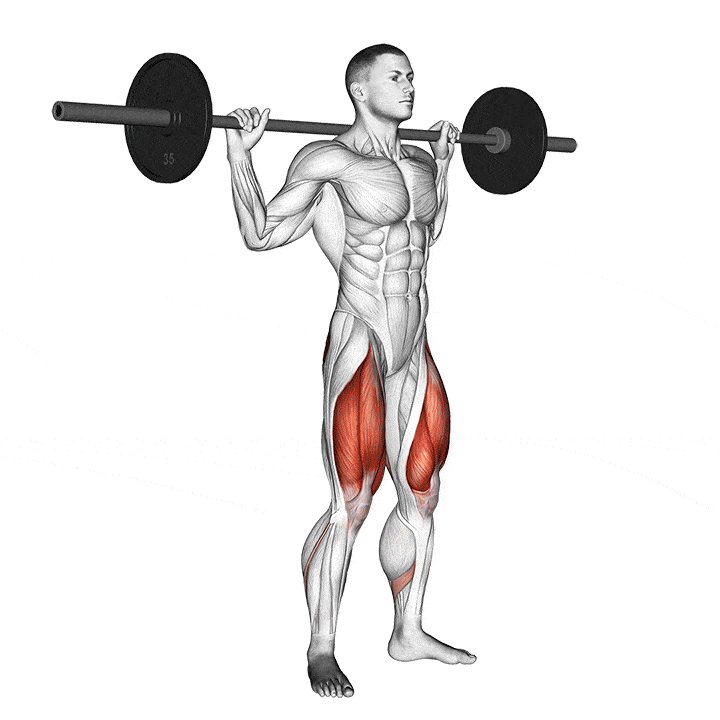
Tips:
- Always use a power rack for heavy squats.
- Increase the depth of your squat as knee health and mobility allow.
- Experiment with the width of your stance to see what works best and is most comfortable for you.
2. Front Squat
Muscles worked: Quadriceps, gluteus maximus, hamstrings, core, abductors, adductors.
Front squats are often favored by athletes because they are better for improving vertical jump height. In contrast, bodybuilders like them because they’re more quadriceps dominant. Either way, front squats are a great alternative to back squats, even if they are a little uncomfortable.
Steps:
- Rack and hold a barbell across the front of your shoulders. Hold it in place with an overhand, shoulder-width grip.
- Stand with your feet between hip and shoulder-width apart.
- Brace your core, lift your chest, and pull your shoulders back and down.
- Bend your knees and squat down until your thighs are roughly parallel to the floor.
- Stand back up and repeat.
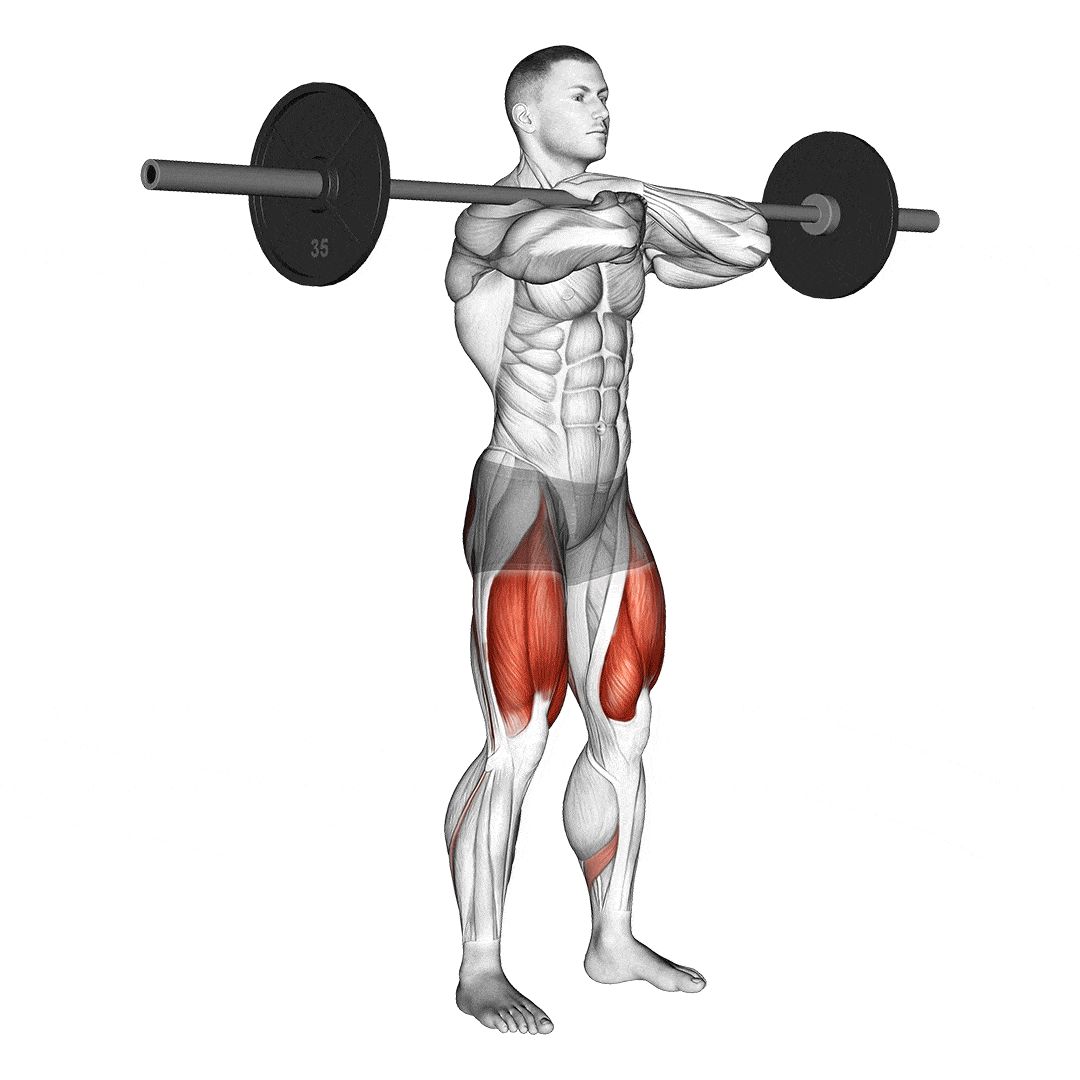
Tips:
- Increase squat depth by resting your heels on a plank or small weight plates.
- Keep your torso as upright as possible to maximize quads engagement.
- Try crossing your arms to take pressure off your wrists.
3. Hack Squat Machine
Muscles worked: Quadriceps, gluteus maximus, hamstrings, abductors, adductors, core.
The hack squat machine is a variation of an old-school exercise called the barbell hack squat. Invented by wrestler and strongman George Hackenschmidt, who was famed for his muscular legs, most gyms have a hack squat machine. This exercise is a great way to target your quads and hips.
Steps:
- Stand on the footplate with your feet around shoulder-to-hip width apart. Place your shoulders under the pads and your back against the backrest. Stand up straight and release the safety handles.
- Bend your knees and descend until your thighs are roughly parallel to the floor.
- Drive your feet into the platform and stand back up.
- Repeat for the desired number of reps.
- Reengage the safety handles and then carefully climb off the machine.
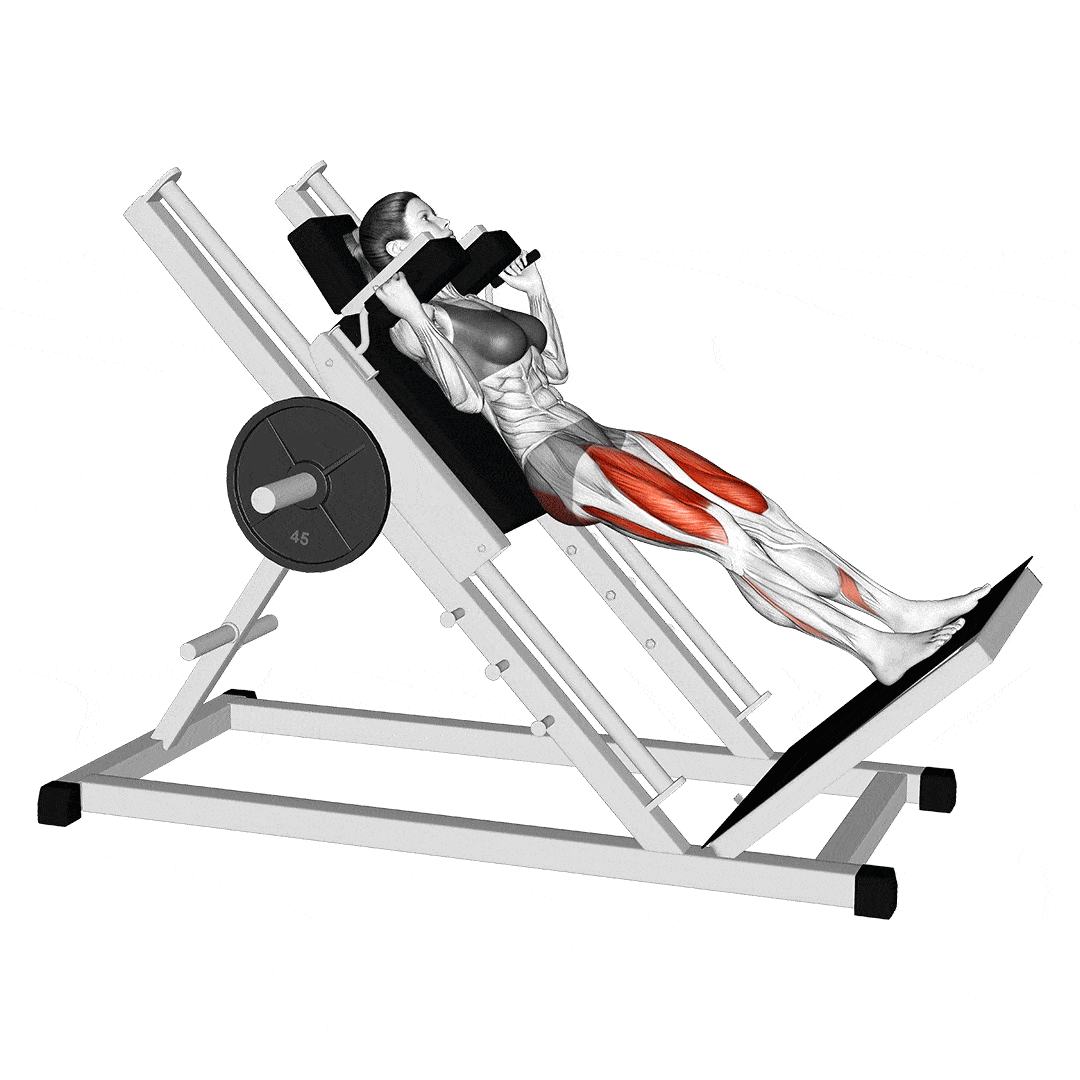
Tips:
- Experiment between a narrow, medium, and wide stance to see which you prefer.
- Push through the balls of your feet to further engage your quadriceps.
- Keep your back pressed against the backrest for comfort and support.
4. Pause Squat
Muscles worked: Quadriceps, gluteus maximus, hamstrings, core, abductors, adductors.
Pause squats are less of an exercise and more of a technique you can apply to many leg exercises to make them more effective. That said, pause squats are also a legitimate exercise in their own right. This exercise will definitely shake up your leg workout. However, don’t go too heavy too soon; this exercise is harder than it sounds.
Steps:
- Set up for a front or back squat. Brace your core and adopt your preferred squat stance.
- Bend your legs and descend until your thighs are at least parallel to the floor.
- Pause in this position for 2-6 seconds.
- Stand up explosively, reset your core, and repeat.
Tips:
- Stay tight during the pause – do not relax.
- Take care not to round your lower back, as doing so can cause injury.
- The longer you pause, the harder this exercise becomes, so adjust as required.
5. Dumbbell Squat
Muscles worked: Quadriceps, gluteus maximus, hamstrings, core, abductors, adductors.
While barbell squats are popular, they have a disadvantage in that you need a power rack to do them safely. This means that barbell squats are often impractical for home exercisers. The good news is that you can get a good leg workout using dumbbells and can just drop the weights if you cannot complete your reps. Safe and simple!
Steps:
- Hold a dumbbell in each hand, arms by your sides, palms facing your legs. Brace your core and pull your shoulders back and down.
- Stand with your feet hip to shoulder-width apart.
- Bend your legs and squat down until your thighs are roughly parallel to the floor.
- Stand back up and repeat.
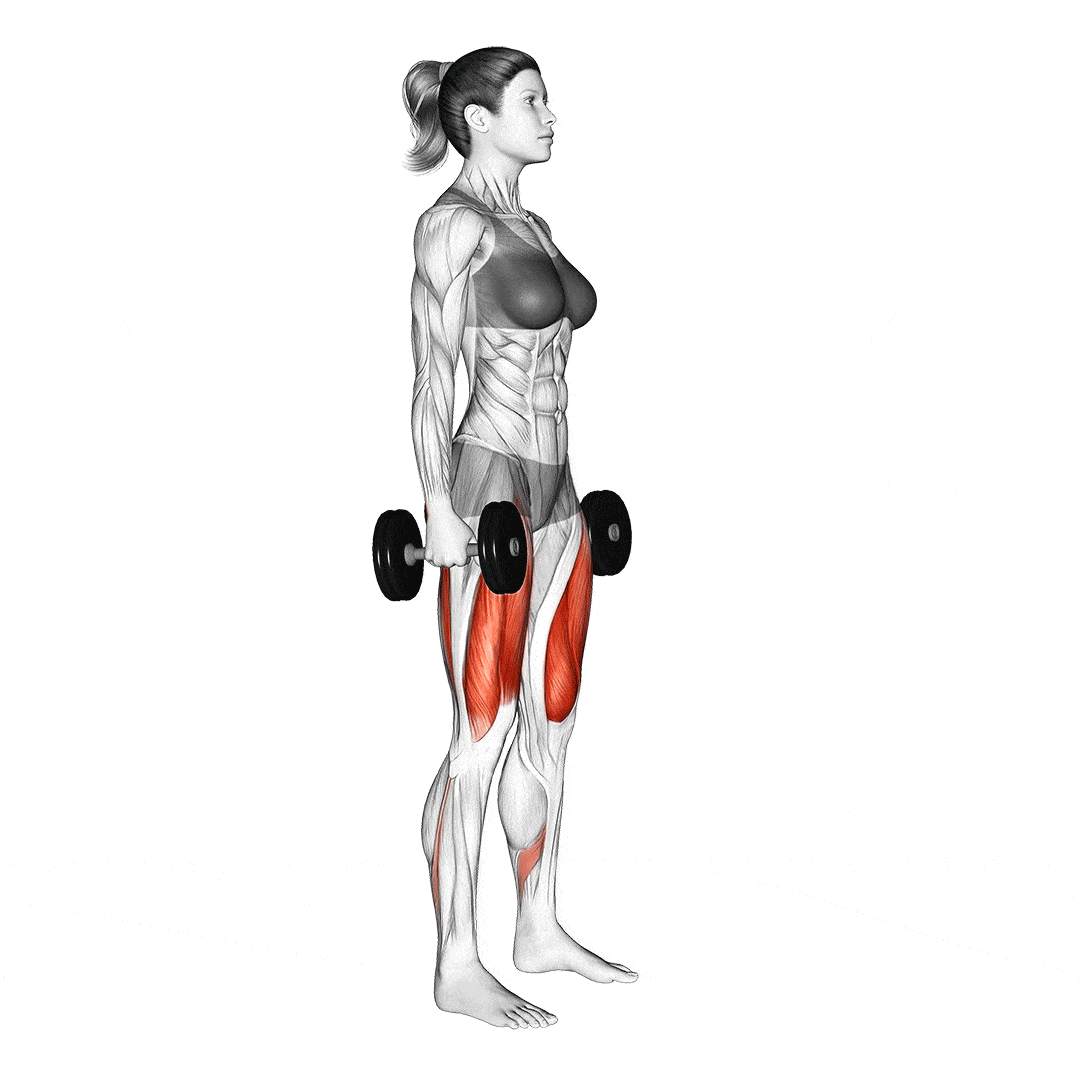
Tips:
- Raise your heels on blocks or weight plates to squat deeper and increase quads engagement.
- Use lifting straps if your forearms tire before your legs.
- You can also do this exercise with an apparatus called a trap or hex bar, which will probably allow you to use heavier weights.
6. Jump Squat
Muscles worked: Quadriceps, gluteus maximus, hamstrings, core, abductors, adductors, calves.
While slow-rep squats and other exercises are good for building strength, they’re less useful for increasing power, which is force generated at speed. Power is a critical component in most sports, especially those that involve sprinting, jumping, or kicking. Athletes do squat jumps to increase leg power, and you should, too!
Steps:
- Stand with your feet shoulder-width apart, knees slightly bent. Brace your core.
- Push your hips back and descend into a quarter-to-half-depth squat.
- Using your arms for extra momentum, leap up and into the air as high as possible. Simultaneously, extend your arms above your head.
- Land on slightly bent knees to absorb the landing, descend into another rep and repeat.
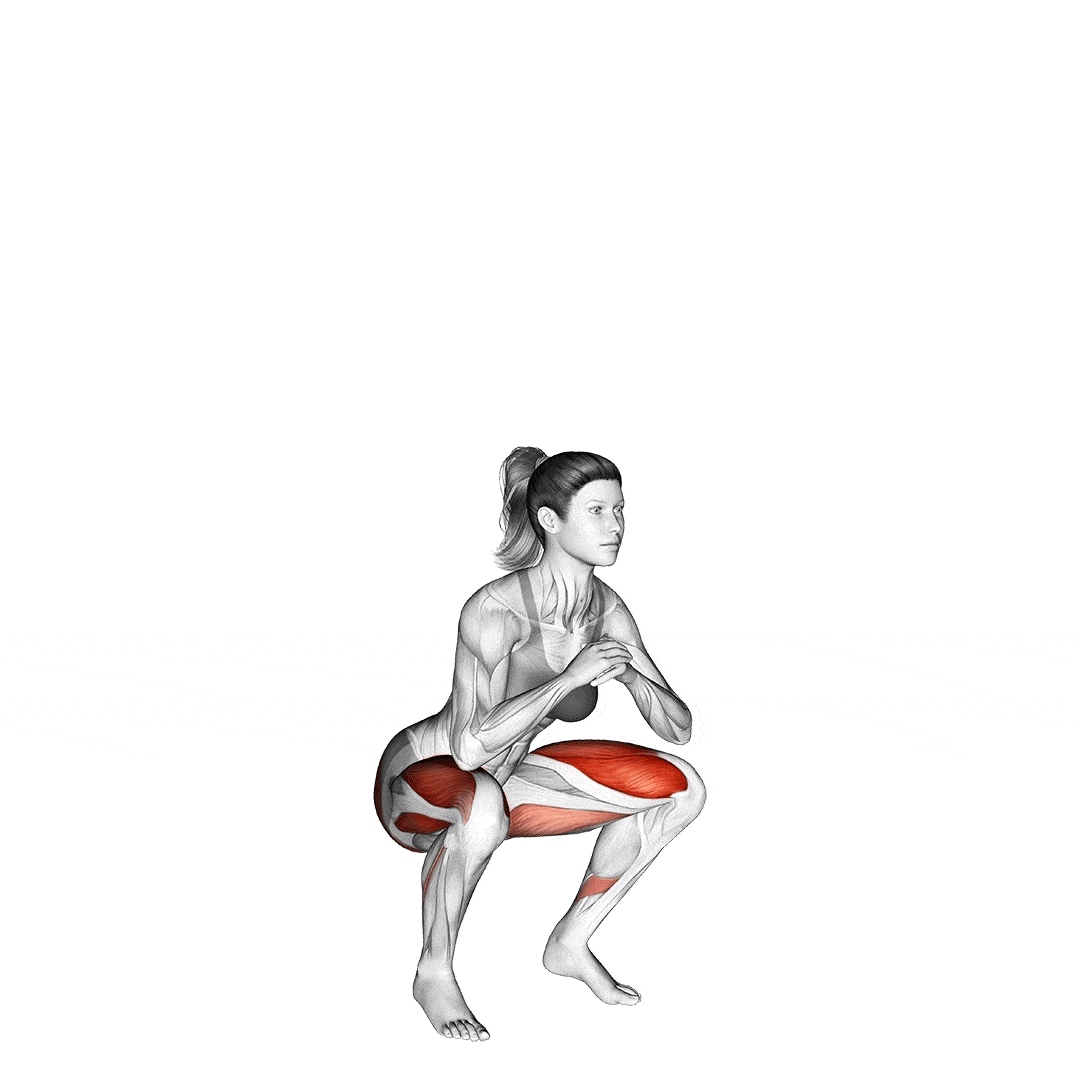
Tips:
- Hold dumbbells in your hands or rest and hold a barbell across your upper back to make this exercise more challenging.
- Jump up and land on a box to lessen the impact. This variation is called box jumps.
- End your set when you notice that your jump height is starting to decrease.
7. Sissy Squat
Muscles worked: Quadriceps, gluteus maximus, hamstrings.
The sissy squat is an old-school leg exercise that will set your quadriceps on fire. Performed correctly, it feels a lot like a bodyweight leg extension. While this exercise can be hard on your knees, it should present no issues if you’ve got healthy knees and perform it with good form. Being overweight is probably worse for your knees than sissy squats!
Steps:
- Stand next to a sturdy upright, such as a squat rack. Hold it for balance. Your feet should be about hip-width apart.
- Bend your knees, push your hips forward, lean back slightly, and descend until your knees are a few inches above the floor. Your knees should travel forward and well beyond your toes.
- Drive the balls of your feet into the floor, extend your knees, and come back up.
- That’s one rep – keep going.
Tips:
- Place a folded mat or foam pad on the floor in front of your feet and imagine trying to touch it with your knees.
- Use your arms for assistance as your quads start to fatigue.
- Hold a dumbbell in one hand or wear a weighted vest to make this exercise more challenging.
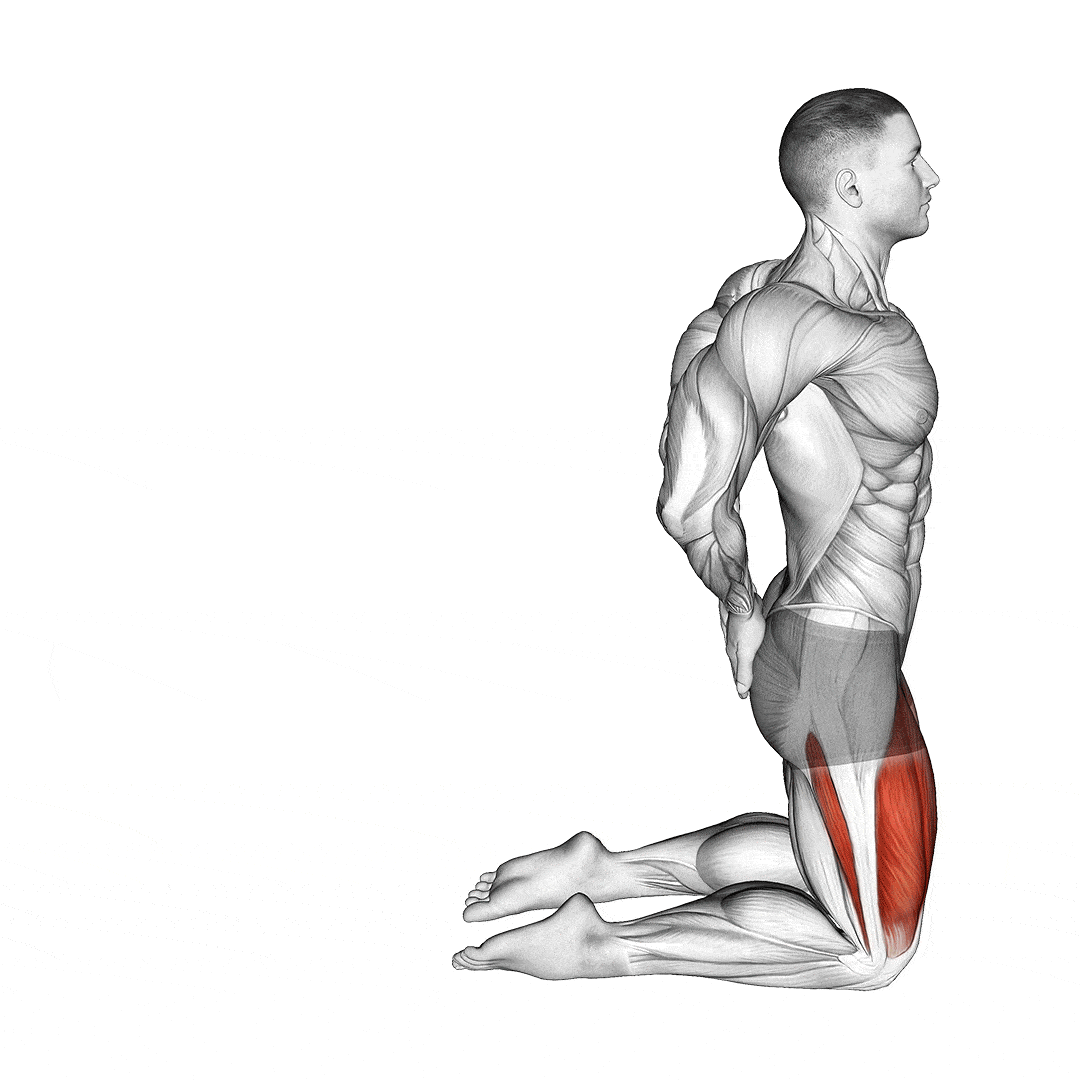
8. Kang Squat
Muscles worked: Quadriceps, gluteus maximus, hamstrings, core, abductors, adductors.
Kang squats combine barbell back squats with good mornings. This makes them one of the few exercises that train your anterior and posterior leg muscles pretty equally. While this is undoubtedly a very challenging exercise, if you need to compress your entire leg workout down into one movement, Kang squats are the one for you.
Steps:
- Rack and hold a barbell across your upper back.
- Stand with your feet about shoulder-width apart, toes turned slightly outward. Brace your core and lift your chest.
- Bend your knees slightly, push your hips to the rear, and hinge forward to perform a good morning. Lean over as far as you can without rounding your lower back.
- Next, bend your knees, bring your hips forward and down, and descend into a squat. Keep your knees apart by contracting your hip abductors.
- Drive your feet into the floor and lift your hips up. Keep your upper body parallel to the floor.
- Finish your rep by pushing your hips forward and standing up.
Tips:
- Hold the barbell firmly so it doesn’t move on your upper back during the good morning phase.
- Do Kang squats in a power rack for safety.
- This exercise works best for low to medium reps with moderate weights, e.g., 4-8.
9. Cyclist Squat
The cyclist squat is so-called because a) bike racers use it to strengthen their quads, and b) bodybuilders use it to build legs that are as big as bike racers! So, if you haven’t guessed, this is a very quads-centric squat variation that’ll help beef up your thighs. It’s also an excellent option for anyone who wants to squat deep but doesn’t have the flexibility to do so.
Muscles worked: Quadriceps, gluteus maximus, hamstrings, abductors, adductors, core.
Steps:
- Place two bumper weight plates on the floor about hip-width apart. Alternatively, use a length of wooden plank.
- Stand with your heels raised and the balls of your feet on the floor.
- Keeping your torso upright, bend your knees, and squat as deeply as you can without rounding your lower back.
- Stand up, stopping just short of locking your knees to keep the tension on your quads.
- Descend again and repeat for the required number of repetitions.
Tips:
- You can do this exercise with your body weight, dumbbells in your hands, a kettlebell in front of your chest, or a barbell across your back as preferred.
- The higher your heels, the more quads-centric this exercise becomes, but it’ll also be harder on your knees.
- Push your knees forward beyond your toes to maximize quads engagement.
10. Goblet Squat
Muscles worked: Quadriceps, gluteus maximus, hamstrings, abductors, adductors, core.
Goblet squats are one of the best home leg training solutions around. This exercise uses a single dumbbell or kettlebell, so you don’t need a squat rack. It also teaches and reinforces good squatting technique. Goblet squats deserve a place in almost every leg workout. TLDR: Goblet squats ROCK!
Steps:
- Hold a kettlebell or dumbbell in front of your chest. Tuck your upper arms into your sides for support and stability. Brace your core and pull your shoulders down and back.
- Stand with your feet shoulder to hip-width apart.
- Bend your legs and squat down until your thighs are at least parallel to the floor. Do not round your lower back.
- Drive your feet into the floor and stand back up.
Tips:
- Raise your heels to increase the depth of your squats.
- Start this exercise with the weight on the floor when using heavy loads. Place it between your feet, squat down, and then curl it into position.
- Hold the weight in one hand to increase lateral core engagement.
11. Pistol Squat
Muscles worked: Quadriceps, gluteus maximus, hamstrings, abductors, adductors, core.
A lot of exercisers dismiss body weight or calisthenic exercises as too easy. Guess they’ve never tried pistol squats, then! This challenging move is basically a highly stylized one-leg squat. As such, it’ll overload your muscles, test your balance, and develop mobility and stability.
Steps:
- Stand with your feet together and your arms extended in front of you. Brace your core. Shift your weight over onto one leg and raise your other leg out in front of you.
- Bend your supporting knee and squat down as deep as you can. Extend your non-working leg out in front of you. Do not allow it to touch the floor.
- Stand back up and repeat.
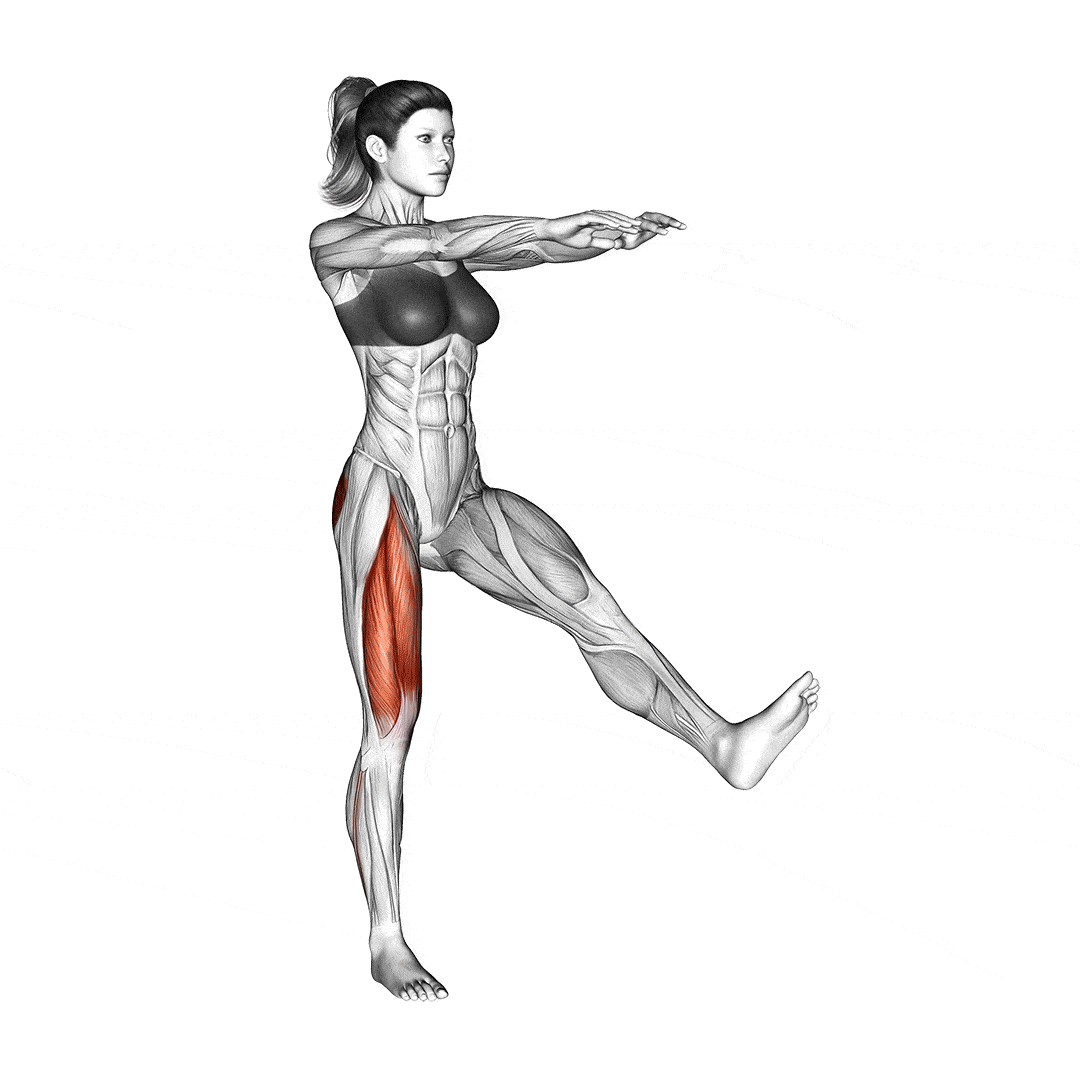
Tips:
- Use a TRX or similar suspension trainer for assistance if necessary.
- Hold a light dumbbell or kettlebell as a counterbalance to make this exercise a little easier.
- Squat down to a box if you tend to fall backward at the bottom of each rep. Lower the box as your balance and mobility improve.
12. Belt Squat
Muscles worked: Quadriceps, gluteus maximus, hamstrings, abductors, adductors.
Squats are typically done using a barbell, dumbbells, kettlebells, or just your body weight. This variation uses a different loading method, which not only changes the feel of the exercise but also removes all the stress from your lower back. This is an excellent exercise for lifters with lower back pain.
Steps:
- Using a dip belt or similar, suspend a weight from your hips. Make sure the chain/rope is strong enough to support the load you are using.
- Step out into a shoulder-to-hip-width stance.
- Bend your legs and squat down until your thighs are roughly parallel to the floor.
- Stand back up and repeat.
Tips:
- Stand on raised platforms if your weights touch the floor before you’ve hit full depth.
- Wrap a towel around your hips if your belt digs into your waist and causes discomfort.
- Experiment with a medium and wide stance to see which works best.
13. Zercher Squat
Muscles worked: Quadriceps, gluteus maximus, hamstrings, core, abductors, adductors.
Powerlifter Ed Zercher had a problem – no squat rack. He got around this by inventing the Zercher squat, which allowed him to train squats without a rack. This exercise is ideal for home workouts and also increases posterior chain engagement, making it a very time-efficient leg exercise.
Steps:
- Hold a barbell in the crooks of your arms. Bend your elbows and clasp your hands together to hold the weight securely in place.
- Brace your core, stand with your feet shoulder-to-hip-width apart, and lift your chest.
- Bend your knees and squat down until your thighs are at least parallel to the floor. Do not round your lower back.
- Drive your feet into the floor and stand back up.
Tips:
- Pad the bar with a folded towel or gym mat for comfort.
- Wear a weightlifting belt for extra back support.
- This exercise works best with a medium to wide stance.
14. Wall Squat
Muscles worked: Quadriceps, hamstrings, gluteus maximus.
The wall squat is an isometric or static leg exercise that’s ideal for home workouts. Additionally, it’s a great way to really burn out your quads at the end of your leg workout. Wall squats are also very knee-friendly, as your joints remain in one position throughout your set.
Steps:
- Stand with your back to a smooth wall. Lean against it and stand with your feet between shoulder to hip-width apart.
- Slide down the wall until your thighs are parallel to the floor.
- Press your lower back into the wall as hard as possible.
- Maintain this position for as long as possible, pushing all the while.
Tips:
- Adjust the height of your squat to hit your legs from different angles.
- Experiment with foot width to see what is most comfortable and effective.
- Push as hard as possible for a short time or less intensely for a longer time. Both approaches work well.
15. Lunge
Muscles worked: Quadriceps, gluteus maximus, hamstrings, abductors, adductors, core.
While bilateral or two-limbed exercises like squats and leg presses are effective, they also tend to hide left-to-right strength imbalances. One way to fix such issues is with single-leg or unilateral exercises like lunges. As an added benefit, lunges improve balance and enhance coordination and mobility, making them a valuable functional movement for athletes.
Steps:
- Stand with your feet together, arms by your sides. Pull your shoulders back and down and brace your core.
- Take a large step forward, bend your legs, and lower your knee down to just above the floor. Keep your torso upright and your front knee behind your toes.
- Push off your front leg to return to the starting position.
- Repeat on the other leg.
- Continue for the prescribed number of reps.
Tips:
- Take shorter steps to emphasize your quads.
- Hold dumbbells to make this exercise more demanding.
- Place your front foot on a 4 to 8-inch platform to increase your range of motion and, therefore, muscle engagement.
You can also do walking lunges, where, instead of bringing your feet back together, you step forward and into your next rep by moving forward. This requires more balance and coordination and is an excellent move for more experienced exercisers.
16. Reverse Lunge
Muscles worked: Gluteus maximus, hamstrings, quadriceps, abductors, adductors, core.
While forward lunges are a mostly quads-dominant exercise, stepping backward makes them more hip-dominant, emphasizing your glutes and hamstrings. This variation is also more knee-friendly and a good option for anyone suffering from knee aches and pains.
Steps:
- Stand with your feet together, arms by your sides. Pull your shoulders back and down and brace your core.
- Take a large step backward, bend your legs, and lower your rear knee down to within an inch of the floor. Keep your torso upright, and make sure your front knee does not travel beyond your toes.
- Push off your back leg and return to the starting position.
- Repeat on the other leg.
- Continue for the prescribed number of reps.
Tips:
- Start by standing on a 4 to 8-inch platform to increase your range of motion and, therefore, the difficulty of this exercise.
- Use dumbbells or a barbell to make this exercise more demanding.
- Alternate legs, or do all your reps on the same side before switching.
17. Lateral Lunge
Muscles worked: Gluteus maximus, hamstrings, quadriceps, abductors, adductors, core.
All lunge variations work your abductors (outer thighs) and adductors (inner thighs) because these muscles must work to stabilize your hips and knees. However, lateral lunges hit these muscles more directly. This is an excellent exercise for racket and team sports players and anyone who wants to hit their legs from all the available angles.
Steps:
- Stand with your feet together and your arms by your sides.
- Take a large step out to the side, bend your outermost leg, and descend until your thigh is roughly parallel to the floor. Push your hips back and keep your chest up. Keep your opposite leg straight.
- Push off your outermost leg and return to the starting position.
- Switch sides and repeat.
Tips:
- Make this exercise more challenging by holding dumbbells or a kettlebell in front of your hips.
- Adjust your range of movement based on your flexibility.
- The more you push your hips back, the more glutes and hamstring engagement you’ll experience.
18. Bulgarian Split Squat
Muscles worked: Quadriceps, hamstrings, gluteus maximus, abductors, adductors, core.
Also known as the rear foot elevated split squat (RFESS), this unilateral leg exercise puts more load on your muscles than lunges and requires more balance. As such, this is an excellent movement for more experienced exercisers. That said, it’s much more accessible than pistol squats, so most people pick it up pretty quickly.
Steps:
- Stand with your back to a knee-high bench or chair. Bend one leg and place the top of your foot on the bench. Hop forward into a split stance.
- Keeping your torso upright, bend your legs and lower your rear knee down toward the floor. Do not allow your front knee to travel forward beyond your toes.
- Straighten your front leg and return to the starting position.
- Continue for the desired number of reps and then switch sides.
Tips:
- Hold dumbbells to make this exercise harder.
- Place your front foot on a raised platform to increase the range of motion and, therefore, the difficulty of the exercise.
- Drive off your front leg and jump to turn this move into a power exercise.
19. Romanian Deadlift
Muscles worked: Gluteus maximus, hamstrings, core.
If you want a more muscular posterior chain, this exercise is the one you want. Romanian deadlifts are a hip-hinge movement that intensely trains your glutes, hamstrings, and lower back. Done with a barbell or dumbbells, this movement is popular with all types of exercisers, from bodybuilders to powerlifters to athletes to soccer moms.
Steps:
- Stand with your feet about hip-width apart, knees slightly bent. Hold your weight in front of your thighs.
- Hinging from your hips, push your butt backward and lean forward as far as your flexibility allows.
- Stand back up, taking care not to lean backward at the top of the movement.
- Continue for the desired number of reps.
Tips:
- Do not round your lower back, as doing so can lead to injuries.
- Place the balls of your feet on thin weight plates to push your weight onto your heels and increase hamstring engagement.
- Use gym chalk to bolster your grip and ensure your hands don’t limit the number of reps performed.
20. Single-leg Romanian Deadlift
Muscles worked: Gluteus maximus, hamstrings, core.
While it’s normal to have one leg stronger than the other, when that strength imbalance becomes too significant, it can lead to dysfunction and injury. Single-leg Romanian deadlifts target one leg at a time and are an effective way to fix any left-to-right strength imbalances. They’re also excellent for improving balance and mobility.
Steps:
- Stand with your feet together, knees slightly bent. Shift your weight over onto one foot.
- Hinging from the hips, lean forward and reach down the front of your leg as far as your flexibility allows. Extend your other leg out behind you for counterbalance.
- Stand back up and repeat.
- Switch sides and do the same number of reps on the opposite leg.
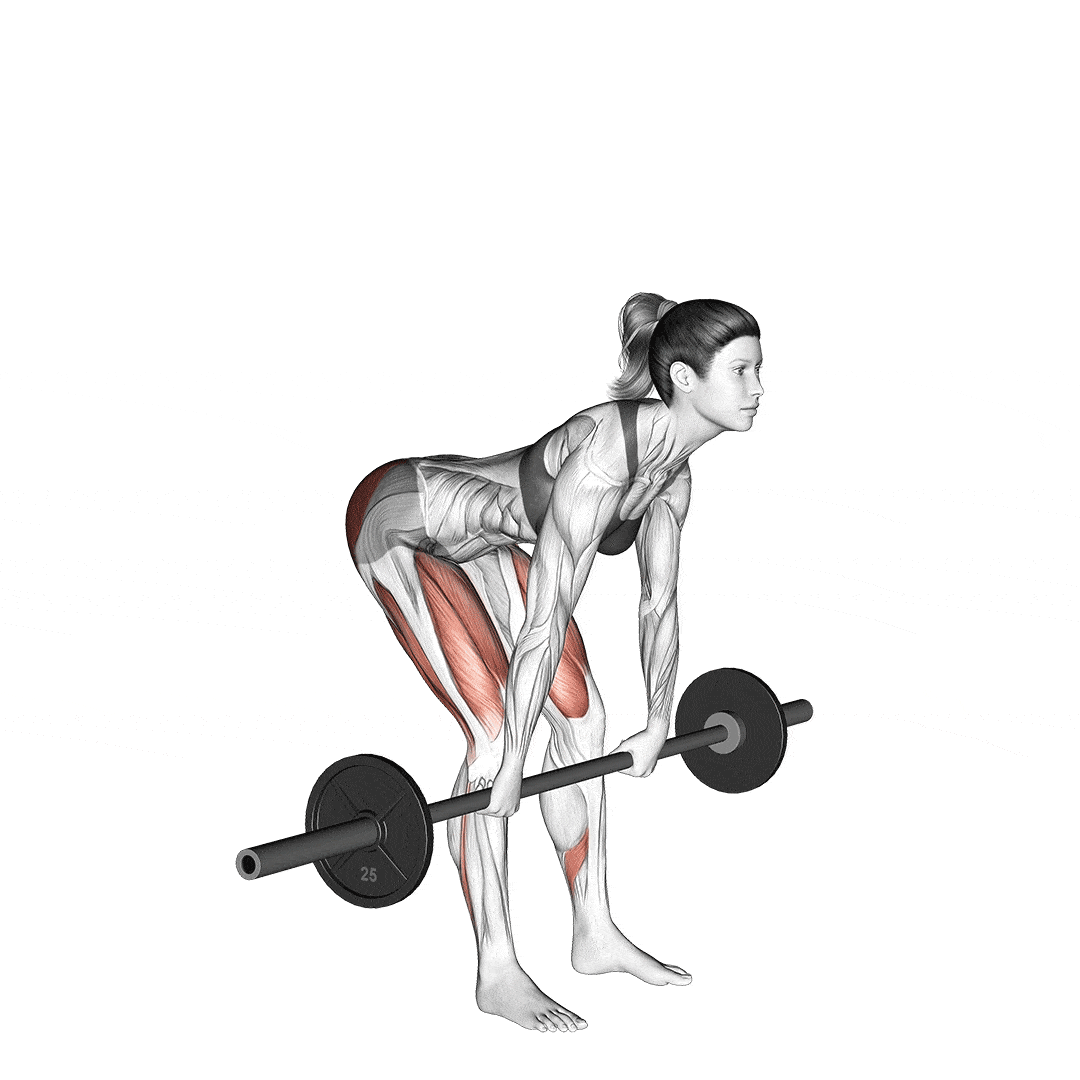
Tips:
- Hold dumbbells or a barbell to make this exercise more challenging.
- Hold onto a handrail or wall for balance if necessary.
- Place your non-working foot on the floor to make this a kickstart or B-stance single-leg Romanian deadlift.
21. Good Morning
Muscles worked: Gluteus maximus, hamstrings, core.
Good mornings are so-called because, when you do them, it looks like you are bowing politely to greet an acquaintance. However, don’t let this genteel name fool you – good mornings are a challenging and effective exercise guaranteed to beef up your posterior chain.
Steps:
- Rack and hold a barbell on your upper back. Stand with your feet hip-width apart, knees slightly bent. Brace your core.
- Push your butt back and hinge forward at the hips, leaning as far as your flexibility allows. Do not round your lower back.
- Drive your hips forward and stand up.
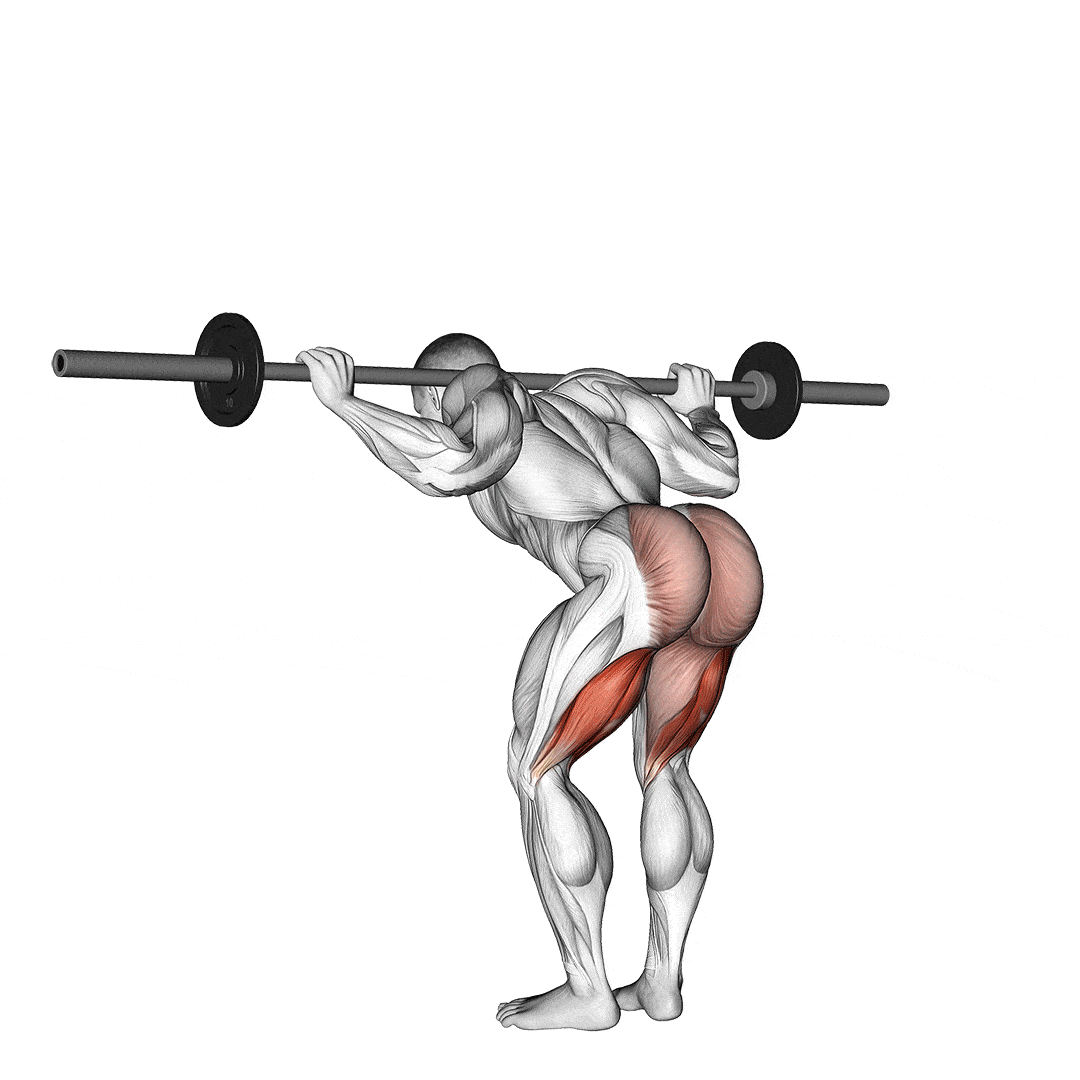
Tips:
- Take care not to round your lower back, as doing so can lead to injury.
- Hold the bar down on your shoulders to stop it rolling up your neck.
- Use a safety bar with padded yoke and handles for comfort.
22. Glute Bridge
Muscles worked: Gluteus maximus, hamstrings, core.
A lot of leg exercises are very challenging or intense. This one is not! While it provides an effective glute and hamstring workout, this exercise is very straightforward and suitable for beginners. Also, with no equipment required, it’s ideal for home workouts.
Steps:
- Lie on your back with your legs bent and feet flat. Brace your core.
- Drive your feet into the floor and lift your hips up so your knees, hips, and shoulders form a straight line.
- Lower your butt back to the floor and repeat.
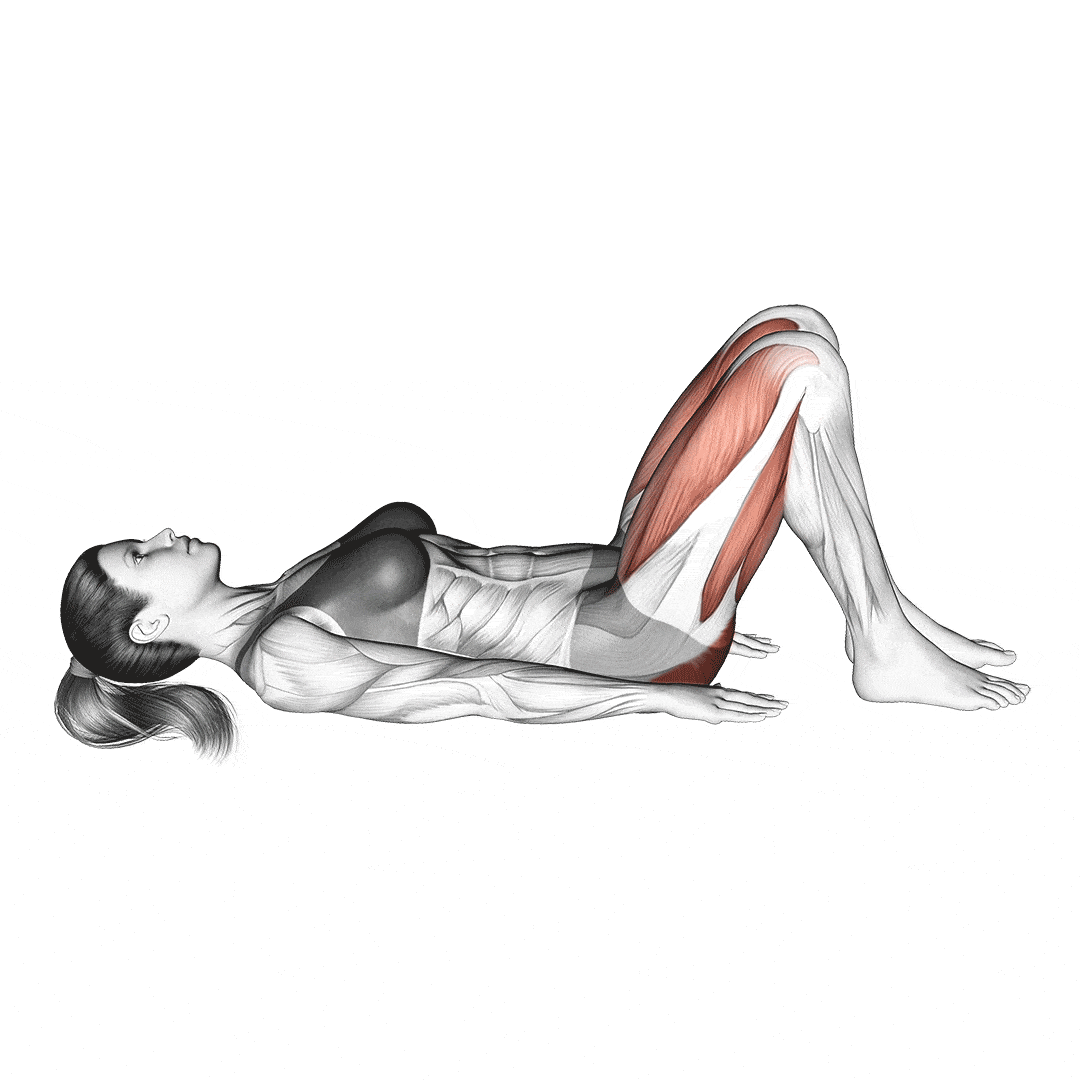
Tips:
- Increase glute engagement by placing a booty band around your knees.
- Make this exercise harder by using one leg at a time.
- Pull your heels in toward your butt to increase hamstring engagement.
23. Barbell Hip Thrust
Muscles worked: Gluteus maximus, hamstrings, core.
While the glute bridge is an effective exercise, most exercisers will outgrow it after a few months of consistent training. The barbell hip thrust is a very similar exercise, but because it uses weight, you can progress it as you get stronger. This exercise grows with you. It’s also very lower-back-friendly and a safe movement for home workouts.
Steps:
- Sit on the floor with your legs outstretched and your upper back resting against a sturdy bench. Roll a barbell up your legs so it’s resting across your hips. Bend your legs and plant your feet flat on the floor.
- Drive your feet into the floor and lift your hips so they form a straight line with your knees and shoulders.
- Pause for 1-2 seconds, lower your butt back to the floor, and repeat.
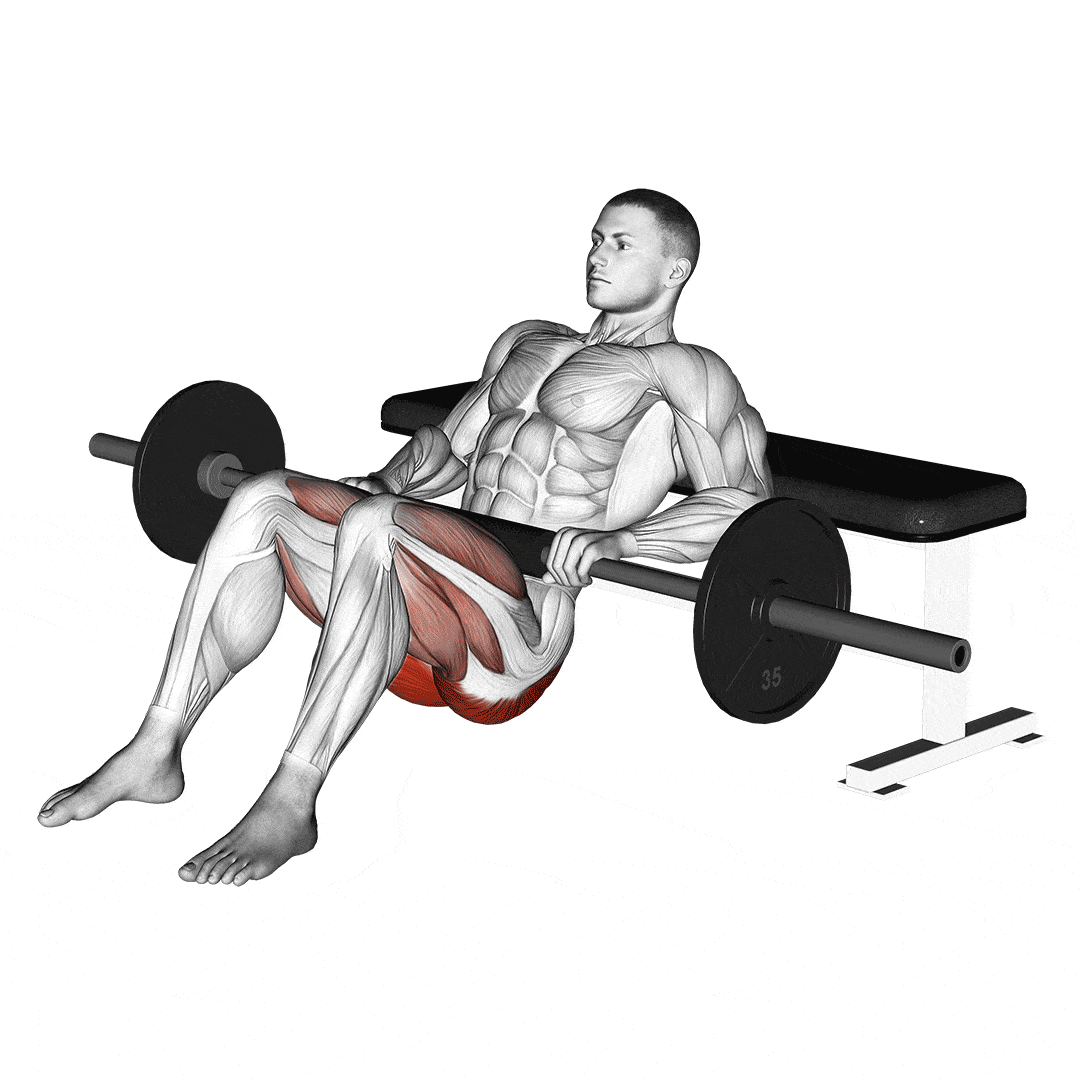
Tips:
- Increase the load to make this exercise more demanding.
- You can use a resistance band instead of a barbell if preferred.
- Do this exercise one leg at a time for a more intense workout.
24. Kettlebell Swing
Muscles worked: Gluteus maximus, hamstrings, core.
Most leg exercises are performed slowly. This ensures the target muscles are kept under constant tension, which helps maximize hypertrophy. However, because of the fitness law of specificity, if you want to increase muscle speed and power, you need to work out at a higher tempo. Kettlebell swings are an explosive hip hinge exercise that is ideal for athletes and anyone looking for a fast-paced lower-body workout.
Steps:
- Hold your kettlebell in front of your hips and stand with your feet shoulder-width apart. Brace your core and pull your shoulders back and down. Bend your knees slightly.
- Hinge forward and lower the weight between your knees. Push your hips back to stretch your hamstrings.
- Drive your hips forward and use this momentum to help you swing the weight forward and up to shoulder height.
- Return to the starting position and repeat.
Tips:
- Do not round your lower back, as doing so could lead to serious injury.
- Make this exercise harder and more core-centric by swinging the weight above your head, AKA an American swing.
- Clench your glutes at the top of each rep to increase muscle engagement.
25. Step-Ups
Muscles worked: Quadriceps, hamstrings, gluteus maximus, abductors, adductors, core.
Step-ups are often viewed as a cardio or fat-burning exercise. And while they can be used for those purposes, they can also be an effective strength and muscle-building move. This exercise is also good for identifying left-to-right strength imbalances and improving balance and coordination.
Steps:
- Stand about 12 inches from a knee-high platform, e.g., a plyo box or bench.
- Lift one leg and place your foot flat on the platform. Push down through that leg and stand up on the step. Try not to push off your trailing leg too much.
- Leading with the same leg, control your descent and step back down.
- Switch leading legs and repeat.
Tips:
- Hold dumbbells to make this exercise more challenging.
- Make sure you place your entire foot on the top of the step each time.
- Lean forward from your hips slightly to pre-stretch and maximize hamstring engagement.
26. Leg Press
Muscles worked: Quadriceps, hamstrings, gluteus maximus.
The leg press is a popular gym exercise. It provides back support and balances and guides the weight so you’re free to focus on pushing the target muscles as hard as possible. While it’s not as functional as squats, lunges, etc., it’s still an excellent exercise that will help build and strengthen your entire lower body.
Steps:
- Sit on the machine and place your feet on the footplate. They should be roughly shoulder-width apart. Extend your legs and flip the safety catches out.
- Bend your legs and lower your knees toward your chest, taking care not to round your lower back.
- Push the weight carriage back up, stopping just short of locking your knees.
- Continue for the desired number of reps.
- Replace the safety catches and exit the machine.

Tips:
- Experiment with the width of your stance to see what feels most comfortable and effective.
- Do not bend your knees too far, as doing so can lead to injury.
- Leg press machines vary from gym to gym, so make sure you ask for guidance when using an unfamiliar model.
Read also Leg Press Variations for Powerful Quadriceps.
27. Leg Extension
Muscles worked: Quadriceps.
Leg extensions are the only exercise that truly isolates the quadriceps. As such, they’re a popular exercise with bodybuilders and anyone else looking to maximize the hypertrophy of this muscle group. Leg extensions are also ideal for muscle-building drop sets, but be warned, they also cause a deep, intense burn in your thighs.
Steps:
- Sit on the machine and adjust the backrest so your knees align with the lever arm pivot point. The leg pad should rest against your lower shins. Hold the handles and lean against the back support.
- Smoothly extend your legs all the way up until your knees are straight.
- Bend your legs, but stop just before the weight plates touch down.
- Continue for the desired number of reps.

Tips:
- Do not kick the weight up, as doing so uses momentum and takes tension off the target muscles.
- Use one leg at a time to increase muscle engagement.
- Pause at the top of each rep for 2-3 seconds and lower the weight slower than you lift it to make this exercise even more effective.
28. Seated Leg Curl
Muscles worked: Hamstrings.
Like leg extensions, seated leg curls isolate your hamstrings, making them a valuable exercise for targeting this often-underdeveloped muscle group. Seated leg curls put your hamstrings into a slightly stretched position, which may make them better for muscle growth than other leg curl variations. However, any differences between machines are very small.
Steps:
- Sit on the machine and adjust the backrest so your knees align with the lever arm pivot point. The leg pad should rest against your lower calves. Hold the handles and lean against the back support.
- Bend your legs and pull your feet in toward your butt.
- Slowly extend your legs, stopping just short of the weights touching down.
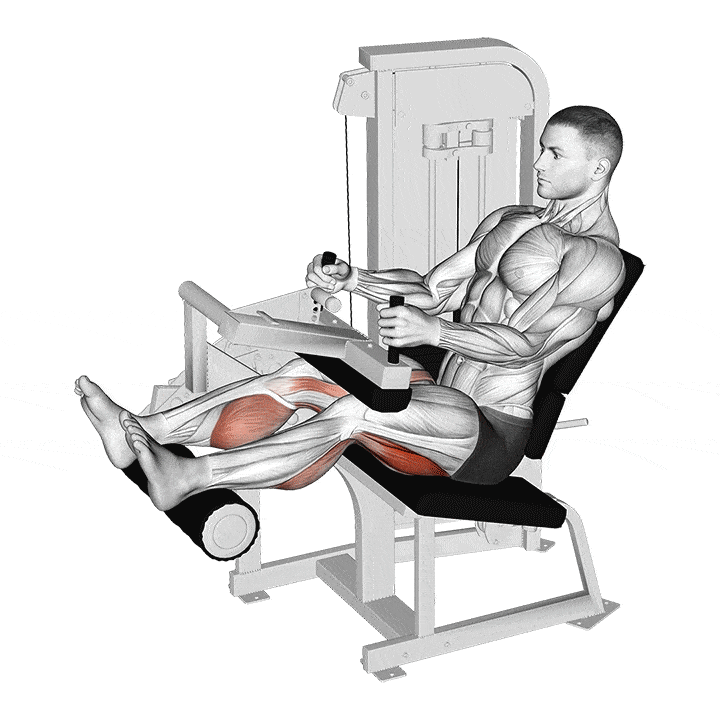
Tips:
- Try to relax your calves to ensure your hamstrings are doing all of the work.
- Do not kick the weight up, as doing so takes work away from the target muscles.
- You can also do this exercise one leg at a time or using an alternating leg action if preferred.
29. Lying Leg Curl
Muscles worked: Hamstrings.
Before the seated leg curl, the lying leg curl was the most widely available hamstring exercise. However, while this move does isolate the hamstrings, it also tends to put more strain on your lower back. As such, it’s critical to keep your core engaged throughout.
Steps:
- Adjust the leg pad so it rests across your lower calves.
- Lie face down on the machine with your legs under the restraints. Brace your core and grip the handles for support.
- Bend your legs and curl your feet up toward your butt.
- Extend your legs, stopping just short of letting the weights touch.
- Continue for the prescribed number of reps.
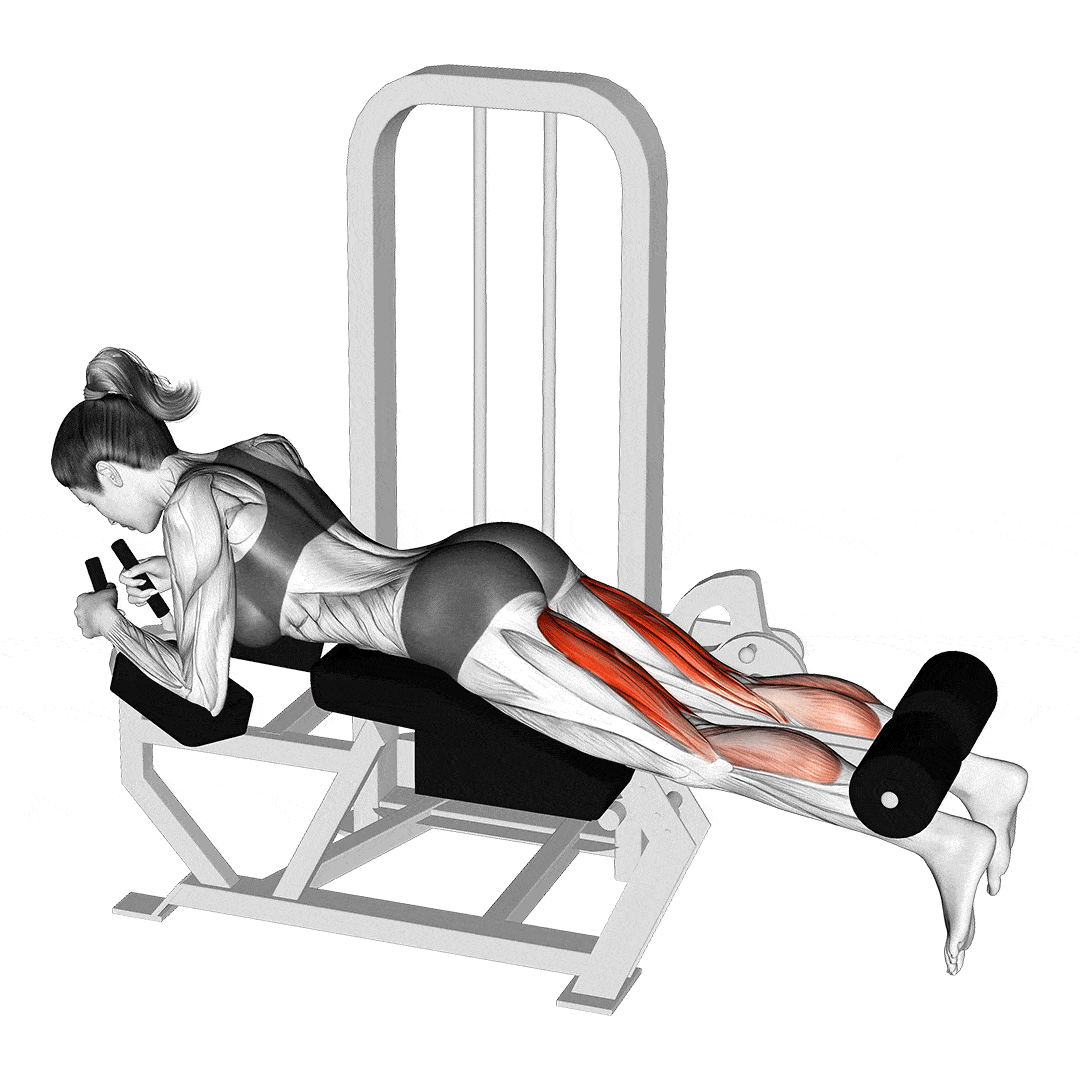
Tips:
- Curl the weight up slowly to keep the tension on the target muscles.
- Do not allow your hips to lift off the bench, as doing so puts stress on your lower back.
- You can do this exercise using one leg at a time or with an alternating leg action if preferred.
30. Standing Leg Curl
Muscles worked: Hamstrings.
Some gyms have standing leg curl machines. These devices put no significant stress on your lower back and allow you to comfortably work one leg at a time. Are they better than seated or standing leg curls? Probably not. However, most lifters appreciate having more than one way to train their hamstrings, making their workouts more varied and interesting.
Steps:
- Stand on the platform and press your thighs against the leg pad. Adjust the ankle roller so it’s just below your calves. Grip the handles for balance.
- Bend one leg and curl your foot up toward your butt.
- Extend your leg, making sure you stop just before the weight touches down.
- Continue for the prescribed number of reps and then change sides.
- Do the same number of reps on the opposite leg.
Tips:
- Lean forward slightly from the hips to pre-stretch your hamstrings and increase muscle activation.
- Pause at the top of each rep and lower the weight more slowly than you lift it for a better hamstring workout.
- You can also do this exercise with a low cable machine and ankle cuff:
31. Nordic Curl
Muscles worked: Hamstrings, gluteus maximus.
You don’t need any equipment to train your hamstrings with Nordic curls. This challenging leg exercise is a bodyweight alternative to machine leg curls and a very effective way to strengthen your hammies. However, be warned: this exercise is tough, so approach it with caution! (4)
Steps:
- Kneel on the floor with your ankles secured with a barbell or similar. Position your hands down by your waist but with your palms facing forward.
- Bend your hips to 30-degree and do not change this position during the movement.
- Very slowly lower your body toward the floor. Use your arms to control your descent as necessary.
- Push yourself back up to the starting position and repeat.
Tips:
- Use your arms less as your hamstrings get stronger.
- Hold a weight plate across your chest, or use a weighted vest to make this exercise harder.
- Use a resistance band to offset some of your body weight and make this exercise a little easier.
32. Sled Push/Pull
Muscles worked: Quadriceps, hamstrings, gluteus maximus, abductors, adductors, core.
When most people think about sled training, they associate it with cardio and high-intensity intervals. However, when loaded appropriately, you can use a sled to build muscle and strength. Depending on which direction you face, you can use a sled to target the front, back, inside, or outside of your legs. This is truly a versatile training method.
Steps:
- Load your sled with an appropriately heavy load.
- Push the sled to target your glutes and hamstrings, or drag it backward to work your quads more.
- Alternatively, pull your sled sideways to work your hip abductors and adductors.
Tips:
- Use very heavy loads and short distances to increase strength and power.
- Use lighter weights and longer distances to build muscle mass and endurance.
- Drag your sled using handles or, for an arms-free workout, use a waist or body harness.
33. Standing Calf Raise
Muscles worked: Gastrocnemius, soleus
No list of the best leg exercises would be complete without calf raises. After all, the calves are critical for both lower body function and aesthetics. Standing calf raises work both your major calf muscles, making it a very time-efficient lower leg exercise. Standing calf raises also lend themselves to lifting heavy weights, so they’re good for building strength, too.
Steps:
- Step onto the standing calf raise machine, positioning your shoulders under the pads and the balls of your feet on the footplate. Your heels should be hanging off the edge.
- Grasp the handles on the machine for stability. Keep your back straight and your core engaged. Look straight ahead and not down at your feet.
- Lower your heels towards the ground, stretching your calf muscles as much as comfortably possible. This is your starting position.
- Push through the balls of your feet to raise your heels as high as you can. At the top, pause briefly to squeeze your calf muscles.
- Slowly lower your heels back to the starting position, feeling the stretch in your calf muscles.
- Continue for the desired number of reps.

Tips:
- Lower your heels down as far as you can, as doing so increases the potential for muscle growth.
- Pause at the top of each rep for maximum muscle engagement.
- You can also do this exercise with a dumbbell or just your body weight:
34. Seated Calf Raise
Muscles worked: Soleus, gastrocnemius.
Seated calf raises emphasize the soleus muscle, which is the lower part of your calf. The larger upper gastrocnemius muscle is still active, but it’s not working as hard as during the standing variation. Both exercises deserve a place in your calf workouts. Still, standing calf raises are arguably the most effective way to build bigger, more muscular lower legs.
Steps:
- Sit down on the calf raise machine and adjust the leg pad to sit across your thighs, just above the knees. Make sure it’s snug but not too tight.
- Place the balls of your feet on the footplate, with your heels hanging off the edge. Your feet should be hip-width apart and parallel to each other.
- Hold onto the handles or the sides of the seat for stability. Make sure your back is straight, and your core is engaged.
- Slowly lower your heels towards the ground, going as far down as comfortably possible to get a good stretch in the calf muscles. This is your starting position.
- Push through the balls of your feet to raise your heels as high as possible. At the top of the movement, pause for a moment and squeeze your calf muscles for maximum contraction.
- Slowly lower your heels back to the starting position, feeling a stretch in the calf muscles as you go down.
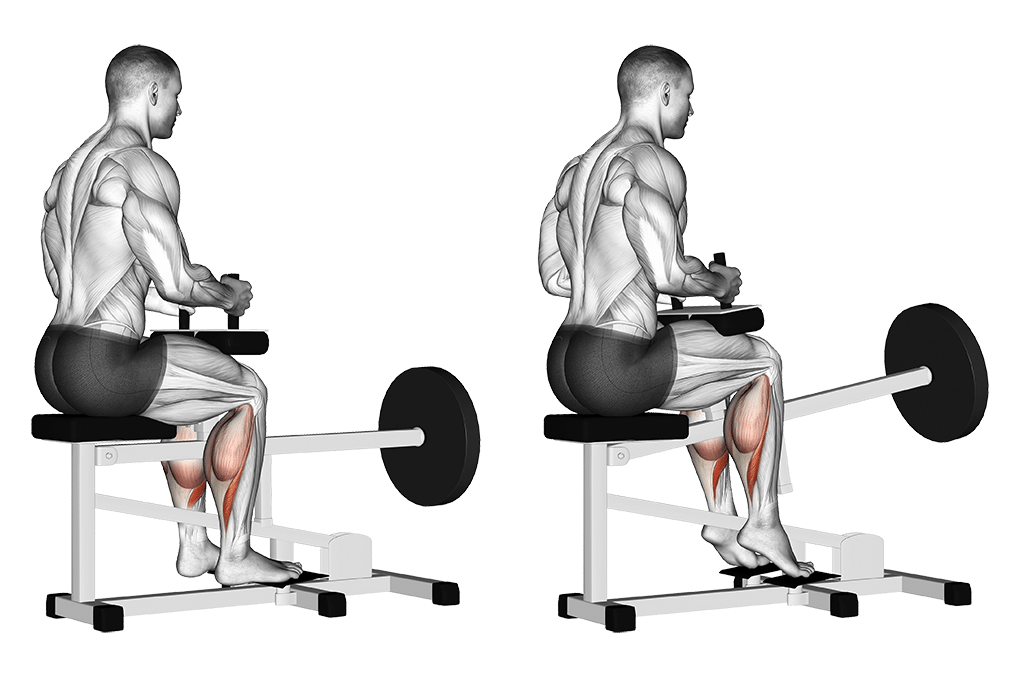
Tips:
- Make sure your shins are vertical before starting your set.
- Avoid leaning back, as doing so takes work away from your calves.
- Use as large a range of motion as possible; half reps get half results!
Safety Tips for Leg Exercises
Leg exercises can and should be very beneficial, building strength and muscle mass in equal measure. However, despite their benefits, some leg exercises can also cause serious injuries because they involve significant loads and put a lot of stress on your lower back.
With that in mind, in this section, we reveal how to make your leg workouts as safe as possible. After all, bodybuilding injuries can keep you out of the gym for weeks or even months, so it pays to avoid them at all costs.
Warm Up and Cool Down Properly
A safe and effective workout starts with a thorough warm-up. Warming up prepares your muscles and joints for what you are about to do, reducing your risk of injury. In addition, your warm-up will ensure your muscles and nervous system are working properly, making your workout more effective.
A good warm-up consists of the following components:
Pulse raiser:
This is the part of the warm-up that makes you warm! It usually comprises 5-10 minutes of easy cardio. Start slow and pick up the pace over several minutes. Take care not to turn your pulse raiser into a workout. You should feel warm at the end, but not tired.
Mobility exercises:
Mobility exercises warm up and lubricate your joints by increasing synovial fluid production, which is an oil-like substance that your body produces on demand. Joint mobility exercises include shallow progressing to deeper bodyweight squats and lunges, hip circles, and ankle rotations. Focus on the joints you are about to use, not forgetting your spine.
Dynamic flexibility exercises:
Static stretches have no place in your warm-up because they put your muscles to sleep and reduce force output potential (strength). Instead, dynamic stretches lengthen and wake up your muscles, making them much more warm-up-appropriate. Good dynamic leg stretches include leg swings, toe touches, and lateral lunges.
Ramped sets:
It would be a mistake to jump straight into heavy training immediately after your warm-up. Rather, it’s better to ramp up to your training weights to prepare your muscles for what you are about to do. This is best done by starting light and increasing your weights over several preparatory sets. For example:
- 10 reps/20kg (empty barbell)
- 8 reps/40kg
- 5 reps/60kg
- 3 reps/80kg
- 10 reps/100kg (first work set).
Read more about warming up for strength training here.
Use Proper Form and Technique
There are two ways to do any exercise – the right way and the wrong way. The right way is safe and effective as it puts plenty of tension on the target muscles while limiting the stress on your joints and connective tissue.
In contrast, the wrong way puts unwanted pressure on your joints, diverts tension away from the muscles you want to target, and significantly increases your risk of injury.
With that in mind, it makes sense to use the proper form and technique for all the exercises in your workouts, even if it means using a little less weight or doing a few less reps.
Breathe and Brace
Breathing is a critical part of safe strength training. Timing your inhalations and exhalations with your repetitions will make it easier to stabilize your core, reducing the stress on your lower back. Ideally, you should inhale at the start of each rep and exhale as you pass through that movement’s sticking point. Needless to say, this can differ from exercise to exercise.
Bracing is the art of contracting your core to maximize the stability of your core. Think of this as “turning on” your natural weightlifting belt. To brace:
- Tense your abs as if expecting a punch to the stomach. Do not pull your abs in. Instead, think of clenching your abdominal muscles.
- Inhale into your abdomen. Feel your entire waistline expand and solidify.
- Time your bracing to create maximal pressure where your chosen exercise is most demanding.
- Exhale between reps, reset your core and repeat.
Increase Weights Gradually
Doing too much too soon is a great way to get injured! While you do need to gradually lift more weight and do more reps to get stronger and more muscular, hurrying the process can be dangerous.
So, only increase the workload when you feel ready, and never at the expense of proper technique or form. If in doubt, put off any weight increases for a week or two to ensure that you are up to it.
Respect Your Body’s Need for Rest and Recovery
“Go hard or go home” might make for a good meme or T-shirt slogan, but when it comes to leg training, such an attitude could be your undoing. Leg exercises like squats and Romanian deadlifts require and take a lot of energy, and doing them hard and often can leave you tired and overtrained.
Too little rest between workouts could mean you start your training sessions already tired, which will have a detrimental effect on your performance. Your technique is more likely to break down if you are tired. After all, mistakes are more common when you are not fully engaged.
So, if you are feeling tired, consider taking a break from the gym or, at least, do fewer exercises and sets and stick to some less complex movements, leg presses, extensions, and curls, all of which require minimal balance and coordination, so there is less to go wrong.
When in doubt, play it safe and come back stronger next time. The alternative is getting hurt, and that could keep you out of the gym for several months.
Use Spotters/Power Racks for Safety
Some leg exercises are more dangerous than others. The riskiest are those that involve holding a weight across your upper back, e.g., barbell squats and lunges. A failed rep can leave you pinned under a heavy weight, which can cause severe injury.
Minimize the risk of accidents by training with a spotter or doing your workout in a power rack. That way, if you cannot complete a rep, you won’t get crushed by a heavy load. Accidents of this nature can cause serious injuries and can even be fatal.
Performance-Boosting Tips for Leg Exercises
Get even more from your leg exercises and workouts with these tried-and-tested performance-boosting training tips!
Use a Variety of Exercises
We have a saying in the fitness industry: If you always do what you have always done, you’ll always get what you’ve always got. In other words, doing the same exercises and workouts over and over is a good way to go nowhere fast!
So, while having a favorite workout or exercises you enjoy more than others is okay, it’s also important to shake things up occasionally and embrace new challenges. After all, easy workouts don’t build muscle and strength, and you need to push out of your comfort zone if you want to get good results from your training.
We’ve shared over 30 leg exercises with you in this guide, so you have more than enough options to make sure your workouts are never repetitive or boring. Use this variety to avoid training ruts and plateaus.
Try Some Plyometric Exercises
Plyometric or jumping exercises are a great way to build muscle power, which is your ability to generate force quickly. Power is an integral part of most sports. Developing muscle power won’t just make you a better athlete. It’ll also make you a more functionally capable human being. Being powerful makes things like running up stairs, lifting heavy weights, and reacting to sudden changes, e.g., avoiding falling over after tripping, much easier and more efficient. Also, power training is fun!
So, while slow-speed strength exercises like squats and lunges are good for building muscle and strength, if you want your muscles to function as well as they look, you should also include plyometric exercises like squat jumps, box squats, kettlebell swings, and hurdle jumps in your workouts.
Focus on Eccentric Contractions
Most exercises involve two types of contraction – concentric or lifting and eccentric or lowering. While both are important, many exercisers focus more on lifting than lowering, making their workouts less effective than they could be.
You are stronger eccentrically than you are concentrically, meaning you can lower more weight than you can lift. You can make the most of this phenomenon by emphasizing the lowering phase of your chosen exercises. For example, for squats, try descending in four seconds and coming back up in two.
There is no need to time your reps, or train in time to a metronome. However, lowering the weight more slowly than you lift it will make your workouts harder and more productive.
Use Training Systems to Make Your Workouts More Challenging
While there is nothing wrong with doing three sets of ten, four sets of eight, or five sets of five with the same weight each time you work out, you can have too much of a good thing. These so-called straight sets can become boring, limiting the effectiveness of your workouts.
Bodybuilders use intensifying methods called training systems to breathe new life into old workouts, making them productive again. Popular training systems include:
- Drop sets
- Supersets
- Pre-exhaust
- Post-exhaust
- Matrix/21s
- Pyramids
- Reverse pyramids
- Static holds
- Partial reps
Each of these methods affects your muscles slightly differently, which, for building muscle, can help prevent training ruts and ensure that your workouts are always as effective as possible.
Be warned; some of these methods are very intense and will probably cause severe post-exercise muscle soreness. With that in mind, introduce these methods gradually and avoid doing too much too soon. Use ’em, but don’t abuse ’em!
Use Resistance Bands/Chains for More Intense Workouts
While there is nothing wrong with the basic version of most barbell leg exercises, using resistance bands or chains can add a new dimension to your lower body workouts. Using bands or chains, a type of training called accommodating resistance, increases the load on your muscles as your limbs approach terminal extension. In short, they make it harder to hit lockout.
This change in the so-called strength curve provides some much-needed variety to your training. Also, it gives additional overload just where you need it – where you are typically strongest.
Powerlifters, who are the strongest squatters and deadlifters on the planet, often use chains and bands to make their workouts more productive. You can use accommodating resistance with several lower body exercises, including:
- Back squats
- Front squats
- Romanian deadlifts
- Good mornings
- Leg press
- Hip thrusts
How to Create a Leg Workout Routine
Randomly picking a few leg exercises and doing them a couple of times a week will provide some benefits. Still, it’s not the best way to organize your training. Instead, if you are serious about making lower body gains, you need to follow a good program.
Writing your own workouts is a skill that takes time to develop. However, once you “get it,” you’ll be able to create effective, safe training programs for almost any training goal. These are the things you need to consider when designing a leg routine:
Consider Your Experience and Goals
It’s very tempting to bite off more than you can chew and follow a program that’s too advanced for your needs and goals. The internet is littered with ultra-intense training programs, each one harder than the next.
The reality is that beginners don’t need long, complicated workouts to build muscle and get strong. In fact, a program of 3-4 exercises will get the job done. More experienced lifters may benefit from slightly longer programs, but even then, gaining strength and muscle needn’t be complicated.
So, the most essential thing to ensure is that your workout matches your experience and goals. Don’t create a powerlifting leg workout when you are a bodybuilder looking to develop maximum muscularity.
Training Volume and Frequency
It’s generally accepted that muscles respond best to about 12-20 weekly training sets. Doing less may produce suboptimal results, while doing more may not provide additional benefits. 12-20 sets seem to be the sweet spot for most people.
You can do all these sets in one workout or, better yet, spread them across two sessions. While training your legs twice a week may not be very appealing, it means neither workout is overly long and, therefore, won’t be excessively tiring. One way to do this is to divide your quads and hamstring training, e.g., squat, leg extensions, and leg press variations on one day and Romanian deadlifts, leg curls, and hip thrusts a few days later.
Ultimately, the best training frequency depends on how much time you can dedicate to working out, and anywhere from 1-3 leg workouts per week can be effective.
Loading
Loading means how much weight you are lifting relative to your one-repetition maximum, or 1RM for short. Broadly speaking, you have three loading options to choose from:
- Low reps/high weight, e.g., 1-5 with 85%+ of your 1RM.
- Medium reps/moderate weight, e.g., 6-15 reps with 60-85% of your 1RM.
- High reps/low weight, e.g., 15-30 reps+ with 30-60% of your 1RM.
While low reps/high loads are invariably best for building strength, almost any other loading and rep scheme can work for building muscle. That said, medium reps and moderate weights are generally the most time-efficient way to train for most people. However, if you prefer high reps and low weights, that’s fine, too.
Most people enjoy a mixture of loading parameters and rep ranges, using heavier weights for compound exercises such as squats and lighter weights for isolation exercises such as leg extensions and hip extensions.
Simply put, providing you take your sets close to failure, your rep count doesn’t actually matter all that much, so feel free to experiment to find the approach that suits you best.
Exercise Variety
The legs are a complex group of muscles that have several different functions. As such, you’ll need a variety of exercises to hit each major muscle with a similar amount of volume. A good leg workout should include exercises for the following:
- Knee extension – quadriceps
- Hip extension – hamstrings and glutes
- Knee flexion – hamstrings
- Hip abduction – gluteus minimus, medius, and tensor fascia latae
- Hip adduction – adductor longus, brevis, and magnus
- Ankle plantarflexion – gastrocnemius and soleus
While some of these actions and muscles overlap and can be worked with a single exercise, others require a more targeted approach. It’s generally best to use the least number of exercises to achieve the best coverage so you have more energy to put into each movement.
So, now you have all the information you need to create your very own leg training routine. But, to help you on your way, here is an example program that adheres to these guidelines:
| Workout One | Workout Two | ||
| Exercise | Sets x Reps | Exercise | Sets x Reps |
| Back squats | 4 x 6-8 | Front squats | 4 x 6-8 |
| Leg extensions | 3 x 8-10 | Leg curls | 3 x 8-10 |
| Lunges | 3 x 10-12 | Romanian deadlifts | 3 x 10-12 |
| Leg press | 3 x 12-15 | Reverse lunges | 3 x 12-15 |
| Standing calf raise | 4 x 12-15 | Seated calf raise | 4 x 12-15 |
FAQ’s
Do you have a question about the best leg exercises or lower body training in general? No problem, because we’ve got the answers!
1. What are the most effective leg exercises for building muscle?
The most effective leg exercises for muscle building are compound movements like squats, deadlifts, and lunges. These exercises engage multiple muscle groups, allowing for greater muscle activation and growth. They also allow you to lift the heaviest loads, which is important for maximizing muscle tension, another driver of muscle growth.
2. How often should I train my legs?
The frequency of leg training depends on your fitness level and goals. For beginners, once a week may suffice, while more advanced lifters may benefit from two or even three sessions per week. That said, two leg workouts, one quads dominant and one hamstring dominant, work well for many people and is a preferred option in many programs.
3. Can I train my legs and upper body on the same day?
There is no reason not to train your lower and upper body in the same session. Still, if you want to do several exercises per muscle group, the volume and energy required may be prohibitively high. For many, it’s better to separate upper and lower body training so you can put maximum effort into both.
4. What’s the difference between high reps and low reps for leg training?
High reps (15-30) with lighter weights are generally used for endurance and toning, while low reps (1-5) with heavier weights are used for building strength. A moderate rep range (6-15) is often used for hypertrophy or muscle growth.
5. Do I need to use weights for effective leg workouts?
While weights can enhance muscle growth and strength, bodyweight exercises like pistol squats, box jumps, and Bulgarian split squats can also be effective for leg training. Ultimately, your body cannot differentiate between using a barbell, leg press machine, or a challenging bodyweight exercise like Nordic curls. So long as you train hard and often enough, your muscles will respond by getting bigger and stronger.
6. How important is nutrition for successful leg training?
Nutrition plays a crucial role in muscle recovery and growth. A balanced diet rich in protein, carbohydrates, and healthy fats can significantly impact your leg training results. If you are training hard but not seeing the results you want, invariably, it’ll be your diet that’s holding you back. As bodybuilders are so fond of saying, if you want to get big, you’ve got to eat big!
7. Can I still train my legs if I have knee pain?
While some exercises can make knee pain worse, it’s still possible to train around knee pain to build and strengthen your legs. Exercises like wall squats, sled pushes and pulls, and step-ups are generally more knee-friendly than squats, leg presses, and leg extensions, so adapt your workouts accordingly.
However, if you have severe or persistent knee pain, it’s generally best to consult a healthcare provider before engaging in leg exercises. The last thing you want to do is to make an existing condition or injury worse.
8. What are plyometric exercises, and how do they benefit leg training?
Plyometric exercises are used by athletes to increase muscle power. They involve a rapid loading/stretching of the target muscles, which respond in turn with a powerful contraction. Most plyometric exercises are jumps and hops, although there are some upper-body plyometric exercises, too.
Plyometrics can improve muscle power, agility, and athletic performance. They can also contribute to muscle growth, albeit indirectly, because they increase squat, deadlift, leg press, etc. performance.
9. How can I avoid plateaus in my leg training?
Plateaus are best avoided by increasing your weights and/or reps whenever you can and changing your workouts when you notice that your progress is slowing down. Typically, this is every 8-12 weeks. Getting 7-9 hours of sleep per night and eating a healthy diet can also help prevent plateaus.
10. Is it necessary to warm up before leg exercises?
Absolutely! Warming up is non-negotiable and prepares your muscles and joints for the workout, reducing the risk of injury. A good warm-up could include 5-10 minutes of cardio, dynamic stretches, joint mobility exercises, and ramped sets to take you to your heavier training weights.
Conclusion
Leg training is critical for your bodybuilding, sporting, and fitness success. Having strong, healthy legs could even enhance your quality of life when you are older. However, despite all those “friends don’t let friends skip leg day” T-shirts and memes, a lot of people either don’t train their legs often enough or use the same old exercises week after week.
Armed with over 30 of the best leg exercises, you now have access to a comprehensive list of movements you can use to achieve any lower body fitness goal. Use these exercises, and your workouts will always be varied, interesting, and, above all, effective.
While having the knowledge is a great start, the real transformation happens when you apply it. It’s essential to set up a routine, get into the gym, and give your leg training the dedication it deserves.
For added inspiration, dive into the 14 Best Legs in Bodybuilding History.
Learn More on Leg Training
The advantages of leg day extend well beyond this article. With a plethora of exercises tailored for the legs and various ways to incorporate them into your regimen, your next enlightening read awaits below:
References:
- Reis VM, Garrido ND, Vianna J, Sousa AC, Alves JV, Marques MC. Energy cost of isolated resistance exercises across low- to high-intensities. PLoS One. 2017 Jul 24;12(7):e0181311. doi: 10.1371/journal.pone.0181311. PMID: 28742112; PMCID: PMC5524349.
- Wirtz N, Zinner C, Doermann U, Kleinoeder H, Mester J. Effects of Loaded Squat Exercise with and without Application of Superimposed EMS on Physical Performance. J Sports Sci Med. 2016 Feb 23;15(1):26-33. PMID: 26957923; PMCID: PMC4763843.
- Mayer F, Scharhag-Rosenberger F, Carlsohn A, Cassel M, Müller S, Scharhag J. The intensity and effects of strength training in the elderly. Dtsch Arztebl Int. 2011 May;108(21):359-64. doi: 10.3238/arztebl.2011.0359. Epub 2011 May 27. PMID: 21691559; PMCID: PMC3117172.
- Schache A. Eccentric hamstring muscle training can prevent hamstring injuries in soccer players. J Physiother. 2012;58(1):58. doi: 10.1016/S1836-9553(12)70074-7. PMID: 22341384.
منبع: https://fitnessvolt.com/best-leg-exercises/
